Abstract
DOI: http://doi.org/10.26333/sts.xxxiii1.08
Lexical concepts (i.e. semantic units conventionally associated with linguistic forms) are viewed in the article as structures consisting of interrelated facets (i.e. conceptual slots filled with various types of information about the referent) with different structural weight. The paper suggests a way to model the graded structure of lexical concepts by assessing the weight of each constituting facet according to its relevance for defining purposes, frequency of contextual profiling and salience in derivation processes. Thus, the approach taken exploits as many linguistic points of access to the concept as possible and uses three different dimensions to range its facets. The suggested idea is verified with a case study of some common lexical concepts in English (e.g. represented by concrete nouns such as “bird”, “tree”, etc.), which reveals both the advantages and the limitations of the approach taken.
References
Ahn, W., Kim, N. S., Lassaline M. E., Dennis, M. J. (2000). Causal Status as a Determinant of Feature Centrality. Cognitive Psychology, 41(4), 361–416.
Allwood, J. (1999). Semantics as Meaning Determination with Semantic-Epistemic Operations. In: J. Allwood, P. Gärdenfors (Eds.), Cognitive Semantics. Meaning and Cognition (pp. 1–18). Amsterdam, Philadelphia: John Benjamins Publishing Company.
Baltatescu, S. (2002). Problems of Transforming Scales of Life Satisfaction [PowerPoint presentation]. Retrieved from: https://studylib.net/doc/9985031/problems-of-transforming-scales-of-life-satisfaction
Biology Dictionary. (2019). Person. Retrieved from: https://www.biology-online.org/dictionary/Person
Bird-Voiced Tree Frog. (n.d.). Retrieved from: https://en.wikipedia.org/wiki/Bird-voiced_tree_frog
Bybee, J. (2003). Phonology and Language Use. Cambridge: Cambridge University Press.
Croft, W., Cruse, A. D. (2004). Cognitive Linguistics. Cambridge: Cambridge University Press.
Evans, V. (2006). Lexical Concepts, Cognitive Models and Meaning-Construction. Cognitive Linguistics, 17(4), 491–534.
Geeraerts, D. (2006). Words and Other Wonders. Papers on Lexical and Other Topics. Berlin, New York: Mouton de Gruyter.
Keil, F., Kim N. S., Grief M. L. (2002). Categories and Levels of Information. In: M. E. Forde, G. Humphreys (Eds.), Category Specificity in Brain and Mind (pp. 375–401). Hove: Psychology Press.
Khalidi, M. A. (1995). Two Concepts of Concept. Mind and Language, 10(4), 402–422.
Kharitonchik, Z. A. (2009). Lexical Meaning as a Dynamic Entity of Variant Semantic Components. Probleme Actuale de Lingvistică, Glotodidactică şi Ştinţă Literară, IV(I), 113–121.
Lakoff, G. (1987). Women, Fire, and Dangerous Things. What Categories Reveal About the Mind. Chicago, London: University of Chicago Press.
Lakoff, G., Turner, M. L. (1989). More Than Cool Reason. A Field Guide to Poetic Metaphor. Chicago, London: University of Chicago Press.
Langacker, R. W. (1987). Foundations of Cognitive Grammar. Theoretical Prerequisites. Stanford: Stanford University Press.
Langacker, R. W. (1991). Foundations of Cognitive Grammar. Descriptive Application. Stanford: Stanford University Press.
Mondofacto. (2019). Retrieved from: http://www.mondofacto.com/facts/dictionary?query=teacher%27s+nodes&action=look+it+up
Murphy, G. L. (2002). The Big Book of Concepts. Cambridge (Massachusetts), London: The MIT Press.
Online Etymology Dictionary. (2019). Retrieved from: www.etymonline.com/
Pattabhiraman, T. (1992). Aspects of Salience in Natural Language Generation. (Ph.D. dissertation, Simon Fraser University, Vancouver).
Pustejovsky, J. (1991). The Generative Lexicon. Computational Linguistics, 17(4), 409–441.
Radden, G., Köpcke, K.-M., Berg, T., Siemund, P. (2007). The Construction of Meaning in Language. In: G. Radden, K.-M. Köpcke, T. Berg, P. Siemund (Eds.), Aspects of Meaning Construction (pp. 1–15). Amsterdam (Philadelphia): John Benjamins Publishing Company.
Rosch, E. (1978). Principles of Categorization. In: E. Rosch, B. B. Lloyd (Ed.), Cognition and Categorization (pp. 27–48). Hillsdale, N.J.: Lawrence Erlbaum Associates.
Sloman, S., Love, B., Ahn, W. (1998). Feature Centrality and Conceptual Coherence. Cognitive Science, 22(2), 189–228.
Taylor, J. R. (2006). Cognitive Linguistics and Cognitive Semantics. In: K. Brown (Ed.), Encyclopedia of Language and Linguistics (Vol. 2, pp. 569–582). Amsterdam: Elsevier Science.
Wierzbicka, A. (1985). Lexicography and Conceptual Analysis. Ann Arbor: Karoma Publishers.
Woman’s Tongue Tree. (n.d.). Retrieved from: https://en.wiktionary.org/wiki/woman%27s_tongue_tree
Wordnik. (2019). Teacher. Retrieved from: https://www.wordnik.com/words/teacher
Sources of Lexicographic Definitions:
AHDEL: American Heritage Dictionary of the English Language. Retrieved from: https://www.ahdictionary.com
CALD: Cambridge Advanced Learner’s Dictionary. (2003). Cambridge University Press.
CED: Collins English Dictionary. Complete and Unabridged. Retrieved from: http://dictionary.reference.com
Collins COBUILD: The Collins COBUILD Advanced Dictionary of American English. (2007). Harper Collins Publishers Ltd.
LDOCE: Longman Dictionary of Contemporary English. Retrieved from: http://www.ldoceonline.com
Macmillan: Macmillan Dictionary. Springer Nature Ltd. Retrieved from: http://www.macmillandictionary.com
MWD: Merriam-Webster Dictionary. Retrieved from: http://www.merriam-webster.com
OD: Oxford Dictionaries. Retrieved from: http://www.oxforddictionaries.com
RHD: Random House Dictionary. Retrieved from: dictionary.reference.com/
WRUD: Webster’s Revised Unabridged Dictionary. DICT Development Group. Retrieved from: http://www.dict.org/
Cited Sources of Idioms:
CD: The Century Dictionary: An Encyclopedic Lexicon of the English Language. Retrieved from: www.micmap.org/dicfro/introduction/century-dictionary
AHDI: The American Heritage Dictionary of Idioms. (1997). Houghton Mifflin.
Source of Contexts:
The British National Corpus, version 3. (2007). Oxford: Oxford University Computing Services, on behalf of the BNC Consortium.


